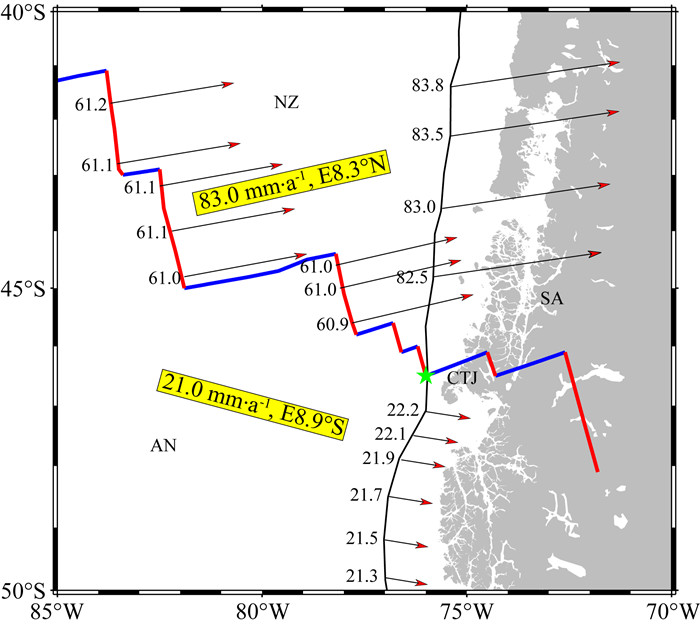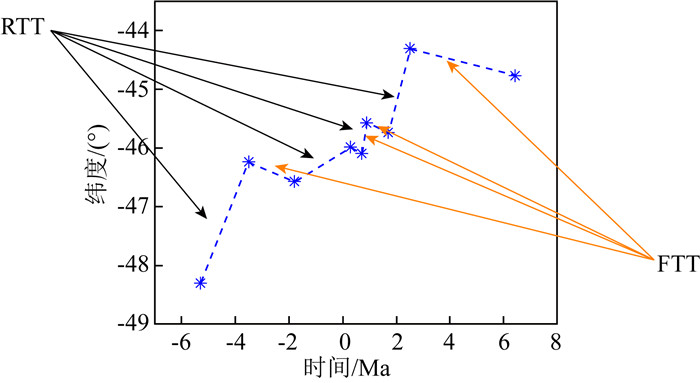2. 中国科学院大学地球与行星科学学院, 北京 100049
2. College of Earth and Planetary Science, University of Chinese Academy of Sciences, Beijing 100049, China
全球板块边界分为汇聚型、离散型与转换断层型三类,包括智利三联点及邻近地区的一类伴随洋脊俯冲的特殊情形(孙转等,2012).所谓智利三联点,是指纳兹卡,南美与南极三个板块两两相互运动的交汇点(约46.2°S,75.2°W),伴随智利洋脊在南美大陆板块之下俯冲(CTJ:Chile triple junction;Cande and Leslie, 1986; Bourgois et al., 1996;Lagabrielle et al., 2000),属于典型的RTT型三联点(王振山和魏东平,2018).在CTJ地区,纳兹卡板块在南美南部的俯冲可以分为三个连续的运动学阶段:自26 Ma以来,俯冲相对于海沟高度倾斜,从26 Ma到20 Ma,俯冲几乎是正交的,自20 Ma以来,俯冲略微倾斜(Pardo-Casas and Molnar, 1987, Cembrano et al., 2002).对现今CTJ附近俯冲情况的研究表明:在CTJ以北,纳兹卡板块和南美板块相对的运动矢量为N80,速度大小为84.0 mm·a-1(Gripp and Gordon, 1990, DeMets et al., 1990),斜向俯冲导致了CTJ北部地区的隆升现象与构造差异,由于汇聚挤压作用,安第斯山脉南部形成了一个主要的弧内右旋挤压断层系统:Liquine-Ofqui断层带(Cembrano et al., 2000, 2002)在CTJ附近地区,智利南部洋脊大约在0.3 Ma前开始俯冲(Cande and Leslie, 1986, Bourgois et al., 2000),正进入CTJ附近的Taitao海沟.自6 Ma以来智利洋脊南部的俯冲包括两个短段(SCR 0和SCR-1,图 1),由断裂带隔开,平均走向为N75(Cande and Leslie, 1986).SCR0段转换断层大约在3 Ma前进入海沟,CTJ向南迁移,形成了一种转换断层-海沟-海沟的构造(Cande and Leslie, 1986, Forsythe et al., 1986, Nelson et al., 1993).在CTJ以南,通过地质调查与地球物理探测技术运用,CTJ迁移的踪迹为:智利洋脊在过去14 Ma期间一直在俯冲(Gripp and Gordon, 1990, DeMets et al., 1990),由于洋脊俯冲作用,弧前地区出现了大陆板块在上,大洋板块在下的现象,当SCR-1段(图 1)俯冲开始时,在6 Ma时间内,Taitao半岛很可能一直是俯冲的地区和蛇绿岩侵位的位置(Lagabrielle et al., 1994, Guivel, 1999); Bougios等(2016)通过构建洋脊段跃迁事件,来解释酸性岩的产出位置问题,在Taitao半岛也发现了显露的洋壳和沉积物被堆积到边缘的地质标志(Bourgois et al., 2000, Lagabrielle et al., 2000); 在智利南部洋脊最新的埋藏段上的弧前地区的地震调查也证实了上下板块之间存在活跃的构造耦合(Murdie et al., 1993).

|
图 1 智利三联点 红色实线为智利洋脊段,蓝色实线为转换断层,黑色虚线为各洋脊段的辅助线,黑色实线为现今NZ板块、AN板块与SA板块的俯冲边界,绿色五角星为智利三联点所在位置,SCR-1至SCR3为每个洋脊段名称,CTJ:智利三联点,AN:南极板块,NZ:纳兹卡板块,SA:南美板块. Fig. 1 Chile triple junction The red solid line is the Chile ridge segment, the blue solid line is the transform fault, the black dashed line is the auxiliary line of each ridge segment, the black solid line is the subduction boundary of the current NZ plate, AN plate and SA plate, and the green five-pointed star is the location of the Chile triple junction. SCR-1 to SCR3 are the names of each ridge segment, CTJ: Chile triple junction, AN: Antarctic plate, NZ: Nazca plate, SA: South America plate. |
从海沟向东,第四纪中期玄武岩侵位在穆尔塔附近的冰川谷中,这些熔岩被认为是与软流层窗口的开放有关(Demant et al., 1998;徐佳静等,2019).再往东距离海沟250 km处有大量碱性玄武岩,也表明CTJ附近存在板片窗构造(Ramos and Kay, 1992).
三联点作为特殊的板块边界,描述了三个板块边界的结合,研究三联点地区的运动学及动力学现象,能够说明板块间的运动关系以及该地区可能存在的地质现象.而智利三联点作为典型的RTT型三联点,更有着智利洋脊俯冲到大陆板块下的独特形式,智利三联点的研究,对于我们研究板块运动以及地质现象的产生原因都有着重要作用.
随着航磁技术,测深技术、地震、地热和GPS等观测技术的发展,也为我们研究智利三联点的运动提供了越来越多的地学观测数据.本文通过对智利三联点地区的转换断层方位角,洋中脊扩展速率,地震滑移矢量以及GPS等数据的分析,给出智利三联点及其邻近地区相关板块两两相对运动的规律,据此进一步讨论其地球动力学意义.
1 数据 1.1 GPS观测数据本文选取了ITRF 2014框架下的GPS观测数据(附录1),其中纳兹卡板块2个数据,南美板块30个数据,南极板块7个数据,太平洋板块18个数据,共57个GPS观测数据(图 2),ITRF2014模型中采用自2000—2015年间的GPS数据,采样间隔7天.整体来说ITRF2014相比ITRF2008GPS数据更加丰富,并且随着GPS技术的发展,数据精度更高,稳定性更好.在ITRF2014框架中,GPS所有站点中误差在1 mm以内,基本实现了亚毫米级定位精度,每一个GPS台站的非线性主周期都进行了拟合,剩余残差的影响降到了最小,因此ITRF2014数据已经完全剔除了影响较大的非线性周期项,对整体的GPS解有质的改善.

|
图 2 南美板块、南极板块、纳兹卡板块上GPS台站速度分布 红色箭头表示GPS速度矢量. Fig. 2 The velocity distribution of GPS stations on the South American plate, Antarctica plate, and Nazca plate The red arrow indicates the GPS velocity vector. |
本文使用的转换断层方位角和洋中脊扩展速率的数据均来自MORVEL板块运动模型采取的数据(表 1),在MORVEL模型的建立中,DeMets等(2010)根据分析数百次的巡游和航空磁测所得到的航磁和测深数据,估计了MORVEL板块扩展速率的所有轨迹线,根据高分辨率多光束或侧扫声纳系统,映射出了133个断层,并从Smith和Sandwell(1997)的1 min海洋重力网格中估计了其长偏移转换断层的方位角.
CTJ附近共有61个在板块边界分布良好的转换断层方位角数据和156个洋脊扩张速率数据(表 1),其中太平洋板块与南极板块边界选取9个转换断层方位角数据和48个扩张速率数据,纳兹卡板块与太平洋板块边界选取15个转换断层方位角数据和41个扩张速率数据,南极板块与南美板块边界选取8个转换断层方位角数据和7个扩张速率数据,纳兹卡板块与南极板块边界上选取29个转换断层方位角数据和60个扩张速率数据.
|
|
表 1 转换断层、扩展速率及地震滑移矢量数据 Table 1 Transform fault spreading rate and earthquake slip vector data |
本文使用的是DeMets等(1990)建立NUVEL-1模型中智利三联点附近208个地震滑移矢量数据(表 1).早先的板块运动模型仅基于体波首次运动的地震机制.而目前许多新机制是结合了体波、面波进行建模,提供了更准确的滑移矢量,CMT的震源机制解是使用记录在全球数字地震网络上的长周期体波和面波推导的,数千个地震震源机制,几乎完全覆盖了板块边界,而最近研究表明,地震滑移矢量可能会导致计算板块运动方向时产生偏差估计,斜向俯冲几乎总是部分的完全分成其沟渠平行和沟渠正交分量,从而导致正交或近乎正交的俯冲平移和旋转(McCaffrey, 1992),Argus等(1989)和DeMets(1993)的研究表明,沿海洋转换断层的走滑地震的滑动方向与转换断层的方位角有系统的不同.
2 研究方法为了计算出智利三联点的运动情况,我们需要计算出纳兹卡板块、南美板块、南极板块的运动情况及其相对应的欧拉矢量(Wei and Seno, 1998),本文使用的计算方法为DeMets等(1990)用于计算NUVEL-1模型时所采用的计算方法,NUVEL-1全球板块运动模型使用了迭代,线性化,加权最小二乘法(Chase,1972;Minster et al., 1974),并最小化了总的、加权的最小二乘误差所得出的:

|
(1) |
其中,m参量表示的是板块运动的特征,由运动方向和速率两部分组成,diobs dipred分别表示第i个资料的观测值与第i个资料的预测值,σi是第i个资料的观测的标准偏差.该模型是由描述每个板块相对于任意一个固定板块的运动的欧拉矢量所组成.
板块运动的数据有两种类型分别为:方向(包括转换断层方位角和地震滑移矢量)和速率.对于每个类型的数据需要不同的拟合函数,我们采取了Chase(1972)提出的拟合函数.
板块运动的预测速率为

|
(2) |
其中vi(=ω×ri)是在ri处预测的线速度,它是第i个数据的位置矢量,ω是描述两个相关板块之间运动的试验欧拉矢量,
Chase(1972)将方向上的误差定义为向量差的大小,


|
(3) |



|
(4) |
根据以上方程,进行迭代计算,当χ2值最小的时候,我们便能够获得一个描述板块系统的最适合模型.
3 计算结果 3.1 描述板块运动的欧拉矢量反演结果对四板块系统(南极板块AN,南美板块SA,纳兹卡板块NZ,太平洋板块PA)进行反演,假定太平洋板块(PA)固定,得到前三个板块相对于太平洋板块的欧拉矢量,求得两两板块之间相对的欧拉矢量.
根据所得到的欧拉矢量,计算每个板块任意点相对太平洋板块的速度,构成智利三联点地区速度场,同时根据两两板块之间相对的欧拉矢量(表 2),求出每个板块在边界点位上的相对水平运动速率.
|
|
表 2 各板块相对于固定板块(PA)的欧拉矢量及两板块之间相对的欧拉矢量 Table 2 The Euler vector of each plate relative to the fixed plate (PA) and the Euler vector between two plates |
纳兹卡板块相对于南美板块的欧拉矢量为(60.343°N,91.969°W,0.772),由此进一步得出智利海沟处,纳兹卡板块相对南美板块的平均俯冲速度约为83.0 mm·a-1,方向大致为东偏北0.7°(图 3).Larson等(1992)和Norabuena等(1999)基于复活节岛和加拉帕戈斯群岛上两个站点GPS数据给出的(40°N,74°W,82.0 mm·a-1)欧拉矢量及78.0 mm·a-1的收敛速度,以及NUVEL-1模型给出的纳兹卡板块相对于南美板块的欧拉矢量(56°N,94°W,0.76)及80.0 mm·a-1收敛速度等,与本文的量级估计值都相当一致.

|
图 3 智利三联点附近板块相对运动 红色箭头表示各板块相对南美板块的运动情况,红色实线为智利洋脊段,蓝色实线为转换断层,黑色实线为现今NZ板块、AN板块与SA板块的俯冲边界,绿色五角星为智利三联点所在位置. Fig. 3 The relative movement of the plates near the Chile triple junction The red arrows indicate the movement of the plates relative to the South American plate. The red line is the Chile ridge segment, the blue line is the transform fault, the black solid line is the subduction boundary of the current NZ plate, AN plate and SA plate, and the green five-pointed star is the location of the Chile triple junction. |
南极板块由于其独特的地理位置,环境因素的影响,对获取大地测量数据带来了相当程度的困难.本文共使用7个位于南极板块的GPS站点数据,以及与南极板块相关联的17个转换断层方位角数据和55个扩张速率数据,反演得到的南极板块相对南美板块的相对欧拉矢量为(81.424°N,25.732°W,0.266).由此我们计算出智利三联点以南地区南极板块对南美板块的俯冲速度,大致为21.6 mm·a-1,方向为东偏南9°(图 3),这一计算结果,与NUVEL-1和MORVEL给出的计算结果都很接近.
4 结果与讨论 4.1 洋脊俯冲对智利三联点地区的影响自晚白垩世以来,安第斯山脉受到大洋岩石层俯冲作用深刻影响了安第斯造山带的构造发育活动.南美西部的汇聚历史可以分为三个阶段:第一阶段(25~0 Ma),速度特征是纳兹卡板块向南美大部分地区的ENE定向汇聚,从新生代的最高值(约150 mm·a-1)持续下降到目前GPS测量当前值(约70.0 mm·a-1).本文中,测定的纳兹卡板块相对南美板块边界平均俯冲速度为83.0 mm·a-1,方向为东偏北4.3°(图 3),结果稍大于大地测量结果.
在智利三联点的南部,智利洋脊的俯冲速度发生了明显变化,本文得出南极板块相对于南美板块的边界速度约为21.0 mm·a-1,方向为东偏南9°(图 3),速度的大小与NUVEL-1模型所估计的20.0 mm·a-1和前人估计的18.5 mm·a-1结果相近.俯冲到南美板块下的纳兹卡板块和南极板块逐渐分离,形成软流层状的板片窗(Cande and Leslie, 1986; Thorkelson, 1996),板片窗向海的边界大致位于Golfo de Penas盆地的中部,这种原因可能是由于纳兹卡板块与南极板块俯冲速度与角度的不同导致的.
Liquine-Ofqui断裂带(LOFZ)是与安第斯南部火山弧共处一处的长达100 km的断裂系统.它的右向剪切运动适应了纳兹卡板块与南美板块之间相对运动的走向平行部分中的很大一部分(Hoffmann-Rothe et al., 2006).LOFZ的南端约为46.5~47.5°S,被智利的扩张洋脊俯冲.扩张洋脊与大陆前端的相互作用对南部LOFZ的运动产生了强烈影响(Nelson et al., 1994),有证据表明,LOFZ的前身在中生代表现出左旋运动(Cembrano et al., 2000).在中新世中期,低空带的右旋运动开始加速(Cembrano et al., 2002),自上新世以来,平均速度的最新估计值在其南部大约为36.0 mm·a-1,向北降低到13.0 mm·a-1.根据NUVEL-1整体板块运动模型(DeMets et al., 1990)的28.0 mm·a-1,以及大地测量的结果和我们的结论,纳兹卡—南美运动目前的余量平行分量仅约23.0 mm·a-1,因此我们估计板块的俯冲运动必定大大降低了这些速度(Angermann et al., 1999; Kendrick et al., 2003).
地质学资料表明,安第斯山脉南部的板块边界带记录了新生代长期大量压变形的历史,这与斜向俯冲或山脊碰撞有因果关系.在一定程度上印证了我们计算结果的合理性.
4.2 智利三联点的南北向振荡迁移运动与酸性岩成因通过CTJ地区洋中脊的俯冲速度矢量结果,图 4给出了6 Ma以来的智利三联点运动轨迹.结果显示,智利洋脊的SCR-1段,在大约5.3 Ma左右开始向南美板块下俯冲(图 4A),俯冲地区主要在Taitao半岛附近.CTJ地区的地质调查也表明,在6 Ma以来智利洋脊的俯冲与岩浆岩套的侵位以及靠近海沟轴的蛇绿岩的逆冲现象是同一时期的(Bourgois et al., 1996, Lagabrielle et al., 1994),通过U-Pb年龄检测,Taitao半岛的蛇绿岩年龄范围在5.7±0.25 Ma(Anma et al., 2009), Bourgois等(1996)分析了Taitao半岛海缘岩体的化学特征,地质背景及运动学的条件,估计了Taitao半岛边缘单元序列,底部地层的年龄大约为上新世(5~5.3 Ma),顶层的地层是更新世早期(1.5~1.6 Ma).由于Taitao半岛地区长期受到俯冲,经历了连续不断的变化,导致海沟向后退和边缘下陷(Scholl et al., 1980; Von Huene and Scholl, 1991),沉降4~6 km,俯冲侵蚀现象是大约从5.3 Ma开始的,说明自6 Ma以来智利洋脊一直向南美板块下俯冲(Guivel, 1999).

|
图 4 智利三联点5.3 Ma前至今的运动情况 红色实线为智利洋脊段,蓝色实线为转换断层,黑色实线为现今NZ板块、AN板块与SA板块的俯冲边界,绿色五角星为智利三联点所在位置,SCR-1至SCR3为每个洋脊段名称,(a) 5.3 Ma前,(b) 3.5 Ma前,(c) 2.5 Ma前,(d) 1.8 Ma前. Fig. 4 Movement of the Chile triple junction from 5.3 Ma ago to now The red solid line is the Chile ridge segment, the blue solid line is the transform fault, the black solid line is the subduction boundary of the current NZ plate, AN plate and SA plate, and the green five-pointed star is the location of the Chile triple junction. SCR-1 to SCR3 are the names of each ridge segment, (a) 5.3 Ma ago, (b) 3.5 Ma ago, (c) 2.5 Ma ago, (d) 1.8 Ma ago. |
在大约3.5 Ma左右(图 4B),智利洋脊的SCR0段南端开始俯冲南美板块,由于智利洋脊被断裂带分隔为几个短段,三联点类型转变为转换断层-海沟-海沟型,三联点呈现由北向南运动,这样将导致的主要后果是在某一片边缘区域,会连续受到几个洋脊段的俯冲.在现今的智利三联点南部,存在一段长约100 km左右的边缘区域经历了两个洋脊段的俯冲(图 4).通过DeLong等(1979)的热模型可知,在距海沟附近10~40 km的近弧前区域,由洋脊俯冲所引起的温度升高在1~2 Ma时间内达到最大,重复的俯冲可能导致非常高的热梯度发展.在800 ~900 ℃的温度条件和低压(10~20 km深度)下,可能导致由海洋或大陆成因的岩石熔化,地质资料表明,在洋壳部分熔融形成陆壳的过程中,洋壳玄武岩经历一次部分熔融后,当熔体与残留物达到相平衡后形成中性岩石,当中性岩石再经历一次部分熔融后才会形成酸性岩.在距三联点仅几公里的不同位置海沟中,发现了极新鲜的酸性岩浆产物(Bourgois et al., 2000, Guivel, 1999).类似的产物在三联点以南10~50 km处的边缘区域均有发现,年龄在1.5~6 Ma之间,弧前酸性岩存在于三联点交替向北向南迁移的位置.
图 5的结果显示,(1)智利三联点整体将向北迁移,但由于转换断层将智利洋脊分隔成了几个不连续的洋脊段,在转换断层俯冲即当三联点为转换断层-海沟-海沟型时,三联点将向南部迁移.(2)现今智利三联点的北部二百多公里处,将会出现多段洋脊俯冲同一位置的现象,其区域大概为100 km左右,并可能出现弧前酸性岩.(3)由于洋脊的俯冲均在Taitao半岛附近,附近区域受到的俯冲侵蚀持续时间长而强烈,可能会导致Taitao半岛附近的海沟持续后退,Taitao半岛持续沉降.

|
图 5 智利三联点未来0~0.7 Ma运动情况 红色线为智利洋脊段,蓝色线为转换断层,黑色线为现今NZ板块、AN板块与SA板块的俯冲边界,绿色五角星为智利三联点所在位置,SCR-1至SCR3为每个洋脊段名称,(a) 0 Ma,(b) 0.3 Ma,(c) 0.7 Ma. Fig. 5 Movement of the Chile triple junction during 0~0.7 Ma The red line is the Chile ridge segment, the blue line is the transform fault, The black line is the subduction boundary of the current NZ plate, AN plate and SA plate, and the green five-pointed star is the location of the Chile triple junction. SCR-1 to SCR3 are the names of each ridge segment, (a) 0 Ma, (b) 0.3 Ma, (c) 0.7 Ma. |
图 6给出智利三联点从5.3 Ma前到今后6.4 Ma纬度的变化,智利三联点整体上是从南到北的运动,但当转换断层开始俯冲南美板块时,即当智利三联点从RTT型转变为FTT型三联点时,CTJ开始由北向南运动,洋脊段开始重复俯冲,我们估计大致有四个重复俯冲的地区,第一次重复俯冲地区大致在46.3°S至46.5°S,第二次重复俯冲地区大致在46°S附近地区,第三次重复俯冲地区大致在45.5°S到45.7°S,第四次重复俯冲地区大致在44.5°S到44.3°S之间.重复的洋中脊俯冲使各地区受到二次熔融的影响从而导致弧前酸性岩的产出,未来6.4 Ma间,弧前酸性岩的产出将会呈点状、片状分布在南美西部智利三联点迁移区域,通过对智利三联点交替向北向南迁移的周期性规律,也对进一步探索地区岩浆热流的周期性变化提供了帮助.

|
图 6 智利三联点纬度随时间的变化关系 横轴为时间,纵轴为三联点所在的纬度. Fig. 6 The relationship between the latitude of the Chile triple junction over time The horizontal axis is time and the vertical axis is the latitude of the triple junction. |
Angermann D, Klotz J, Reigber C. 1999. Space-geodetic estimation of the Nazca-South America Euler vector. Earth and Planetary Science Letters, 171(3): 329-334. DOI:10.1016/S0012-821X(99)00173-9 |
Anma R, Armstrong R, Orihashi Y, et al. 2009. Are the Taitao granites formed due to subduction of the Chile ridge?. Lithos, 113(1-2): 246-258. DOI:10.1016/j.lithos.2009.05.018 |
Argus D F, Gordon R G, DeMets C, et al. 1989. Closure of the Africa-Eurasia-North America plate motion circuit and tectonics of the Gloria fault. Journal of Geophysical Research: Solid Earth, 94(B5): 5585-5602. DOI:10.1029/JB094iB05p05585 |
Bourgois J, Martin H, Lagabrielle Y, et al. 1996. Subduction erosion related to spreading-ridge subduction: Taitao peninsula (Chile margin triple junction area). Geology, 24(8): 723-726. DOI:10.1130/0091-7613(1996)024<0723:SERTSR>2.3.CO;2 |
Bourgois J, Guivel C, Lagabrielle Y, et al. 2000. Glacial-interglacial trench supply variation, spreading-ridge subduction, and feedback controls on the Andean margin development at the Chile triple junction area (45~48°S). Journal of Geophysical Research: Solid Earth, 105(B4): 8355-8386. DOI:10.1029/1999JB900400 |
Bourgois J, Lagabrielle Y, Martin H, et al. 2016. A review on forearc ophiolite obduction, Adakite-like generation, and slab window development at the Chile triple junction area: uniformitarian framework for spreading-ridge subduction. Pure and Applied Geophysics, 173(10-11): 3217-3246. DOI:10.1007/s00024-016-1317-9 |
Cande S C, Leslie R B. 1986. Late Cenozoic tectonics of the southern Chile trench. Journal of Geophysical Research: Solid Earth, 91(B1): 471-496. DOI:10.1029/JB091iB01p00471 |
Cembrano J, Lavenu A, Reynolds P, et al. 2002. Late Cenozoic transpressional ductile deformation north of the Nazca-South America-Antarctica triple junction. Tectonophysics, 354(3-4): 289-314. DOI:10.1016/S0040-1951(02)00388-8 |
Cembrano J, Schermer E, Lavenu A, et al. 2000. Contrasting nature of deformation along an intra-arc shear zone, the Liquiñe-Ofqui fault zone, southern Chilean Andes. Tectonophysics, 319(2): 129-149. DOI:10.1016/S0040-1951(99)00321-2 |
Chase C G. 1972. The N plate problem of plate tectonics. Geophysical Journal of the Royal Astronomical Society, 29(2): 117-122. DOI:10.1111/j.1365-246X.1972.tb02202.x |
DeLong S E, Schwarz W M, Anderson R N. 1979. Thermal effects of ridge subduction. Earth and Planetary Science Letters, 44(2): 239-246. DOI:10.1016/0012-821X(79)90172-9 |
Demant A, Belmar M, Hervé F, et al. 1998. Pétrologie et éochimie des basaltes de murta: une éruption sous-glaciaire dans les andes patagoniennes (46°lat.S.), chili. relation avec la subduction de la ride du chili. Comptes Rendus de l'Académie des Sciences-Series ⅡA-Earth and Planetary Science, 327(12): 795-801. |
DeMets C, Gordon R G, Argus D F, et al. 1990. Current plate motions. Geophysical Journal International, 101(2): 425-478. DOI:10.1111/j.1365-246X.1990.tb06579.x |
DeMets C. 1993. Earthquake slip vectors and estimates of present-day plate motions. Journal of Geophysical Research: Solid Earth, 98(B4): 6703-6714. DOI:10.1029/92JB02868 |
DeMets C, Gordon R G, Argus D F. 2010. Geologically current plate motions. Geophysical Journal International, 181(1): 1-80. DOI:10.1111/j.1365-246X.2009.04491.x |
Forsythe R D, Nelson E P, Carr M J, et al. 1986. Pliocene near-trench magmatism in southern Chile: a possible manifestation of ridge collision. Geology, 14(1): 23-27. DOI:10.1130/0091-7613(1986)14<23:PNMISC>2.0.CO;2 |
Gripp A E, Gordon R G. 1990. Current plate velocities relative to the hotspots incorporating the NUVEL-1 global plate motion model. Geophysical Research Letters, 17(8): 1109-1112. DOI:10.1029/GL017i008p01109 |
Guivel C. 1999. Subduction d'une dorsale océanique active: interactions magmatiques et tectoniques. Le cas du point triple du Chili[Ph. D. thesis]. Brest France: Université de la Bretagne Occidentale, 577.
|
Hoffmann-Rothe A, Kukowski N, Dresen G, et al. 2006. Oblique convergence along the Chilean margin: Partitioning, margin-parallel faulting and force interaction at the plate interface. //Oncken O, Chong G, Franz G, et al eds. The Andes. Berlin: Springer, 125-146.
|
Kendrick E, Bevis M, Smalley R Jr, et al. 2003. The Nazca-South America Euler vector and its rate of change. Journal of South American Earth Sciences, 16(2): 125-131. DOI:10.1016/S0895-9811(03)00028-2 |
Lagabrielle Y, Le Moigne J, Maury R C, et al. 1994. Volcanic record of the subduction of an active spreading ridge, Taitao Peninsula (southern Chile). Geology, 22(6): 515. DOI:10.1130/0091-7613(1994)022<0515:VROTSO>2.3.CO;2 |
Lagabrielle Y, Guivel C, Maury R C, et al. 2000. Magmatic-tectonic effects of high thermal regime at the site of active ridge subduction: the Chile Triple Junction model. Tectonophysics, 326(3-4): 255-268. DOI:10.1016/S0040-1951(00)00124-4 |
Larson R L, Searle R C, Kleinrock M C, et al. 1992. Roller-bearing tectonic evolution of the Juan Fernandez microplate. Nature, 356(6370): 571-576. DOI:10.1038/356571a0 |
McCaffrey R. 1992. Oblique plate convergence, slip vectors, and forearc deformation. Journal of Geophysical Research: Solid Earth, 97(B6): 8905-8915. DOI:10.1029/92JB00483 |
Minster J B, Jordan T H, Molnar P, et al. 1974. Numerical modelling of instantaneous plate tectonics. Geophysical Journal of the Royal Astronomical Society, 36(3): 541-576. DOI:10.1111/j.1365-246X.1974.tb00613.x |
Murdie R E, Prior D J, Styles P, et al. 1993. Seismic responses to ridge-transform subduction: Chile triple junction. Geology, 21(12): 1095-1098. DOI:10.1130/0091-7613(1993)021<1095:SRTRTS>2.3.CO;2 |
Nelson E, Forsythe R, Diemer J A, et al. 1993. Taitao ophiolite: a ridge collision ophiolite in the forearc of southern Chile (46°S). Revista Geologica De Chile, 20(2): 137-165. |
Norabuena E O, Dixon T H, Stein S, et al. 1999. Decelerating Nazca-South America and Nazca-Pacific plate motions. Geophysics Research Letters, 26(22): 3405-3408. DOI:10.1029/1999GL005394 |
Pardo-Casas F, Molnar P. 1987. Relative motion of the Nazca (Farallon) and South American Plates since Late Cretaceous time. Tectonics, 6(3): 233-248. DOI:10.1029/TC006i003p00233 |
Ramos V A, Kay S M. 1992. Southern Patagonian plateau basalts and deformation: Backarc testimony of ridge collisions. Tectonophysics, 205(1-3): 261-282. DOI:10.1016/0040-1951(92)90430-E |
Scholl W D, Von Huene R, Vallier T L, et al. 1980. Sedimentary masses and concepts about tectonic processes at underthrust ocean margins. Geology, 8(12): 564-568. DOI:10.1130/0091-7613(1980)8<564:SMACAT>2.0.CO;2 |
Smith W H F, Sandwell D T. 1997. Global sea floor topography from satellite altimetry and ship depth soundings. Science, 277(5334): 1956-1962. DOI:10.1126/science.277.5334.1956 |
Sun Z, Yang F L, Zhang N, et al. 2012. Advances in study of triple junctions. Geological Review (in Chinese), 58(6): 1133-1143. |
Thorkelson D J. 1996. Subduction of diverging plates and the principles of slab window formation. Tectonophysics, 254(1-2): 47-65. |
Von Huene R, Scholl D W. 1991. Observations at convergent margins concerning sediment subduction, subduction erosion, and the growth of continental crust. Reviews of Geophysics, 29(3): 279-316. DOI:10.1029/91RG00969 |
Wang Z S, Wei D P. 2018. Research progress on the formation and evolution of triple junctions of global plate motions. Progress in Geophysics (in Chinese), 33(5): 1834-1843. |
Wei D P, Seno T. 1998. Determination of the Amurian plate motion. //Flower M F J, Chung S L, LO C H, et al eds. Mantle Dynamics and Plate Interactions in East Asia. Washington D.C. : American Geophysical Union, 27: 337-346.
|
Wessel P, Luis J F, Uieda L, et al. 2019. The Generic Mapping Tools version 6.Geochemisty. Geophysics, Geosystems, 20: 5556-5564. DOI:10.1029/2019GC008515 |
Xu J J, Wang Z S, Wang S P, et al. 2019. Numerical simulation of the lithospheric thermal structure in the subduction zone of the Southern Chile triple junction. Chinese Journal of Geophysics (in Chinese), 62(12): 4729-4737. DOI:10.6038/cjg2019M0592 |
孙转, 杨风丽, 张娜, 等. 2012. 三联点研究进展. 地质论评, 58(6): 1133-1143. DOI:10.3969/j.issn.0371-5736.2012.06.013 |
王振山, 魏东平. 2018. 全球板块运动三联点形成与演化规律的研究进展. 地球物理学进展, 33(5): 1834-1843. |
徐佳静, 王振山, 王少坡, 等. 2019. 智利三联点南部俯冲区域岩石层热结构的数值模拟. 地球物理学报, 62(12): 4729-4737. DOI:10.6038/cjg2019M0592 |
 2021, Vol. 64
2021, Vol. 64


